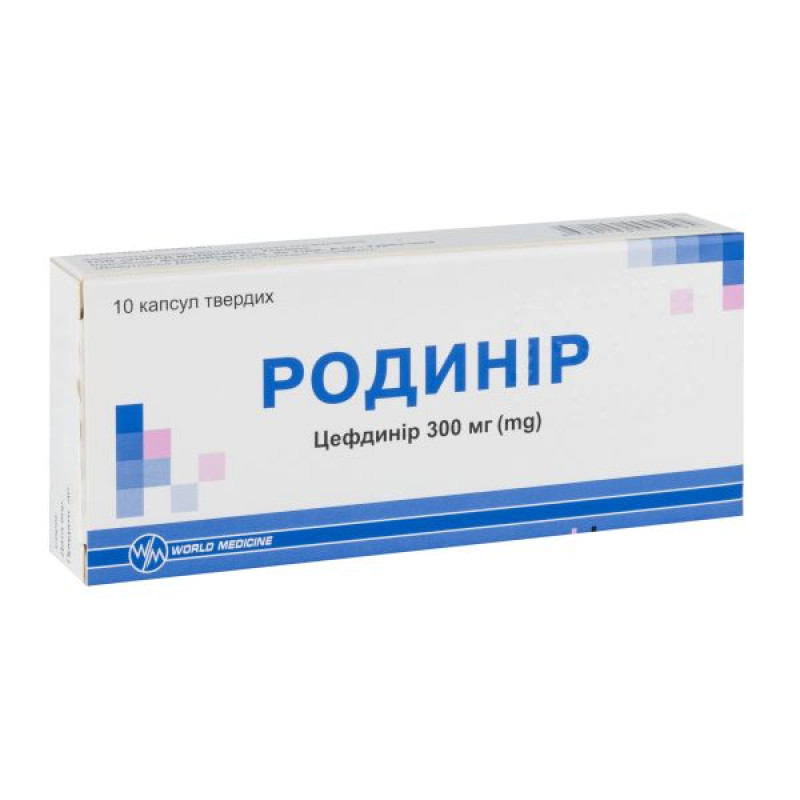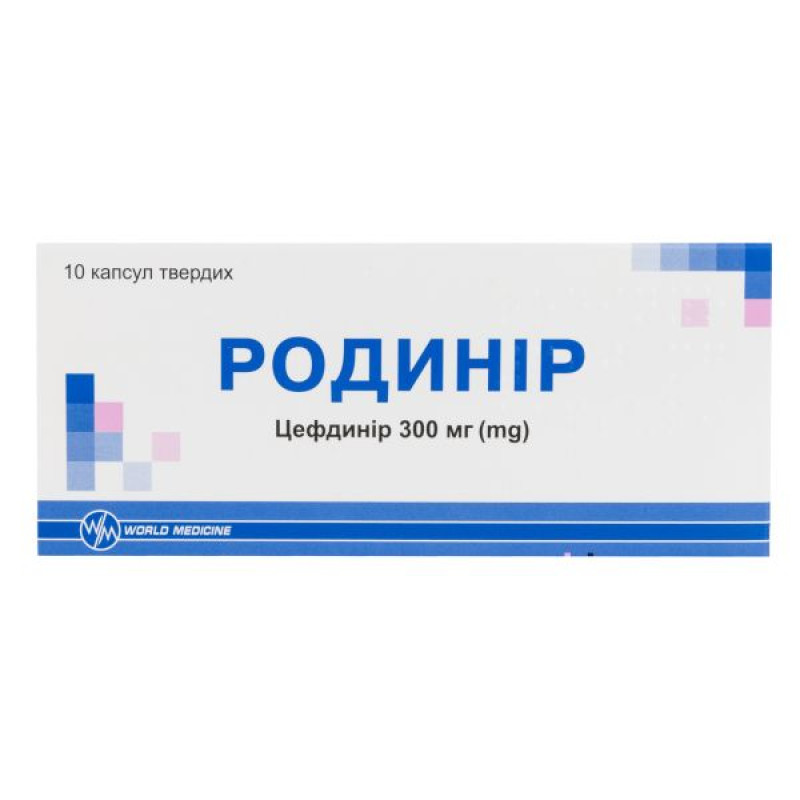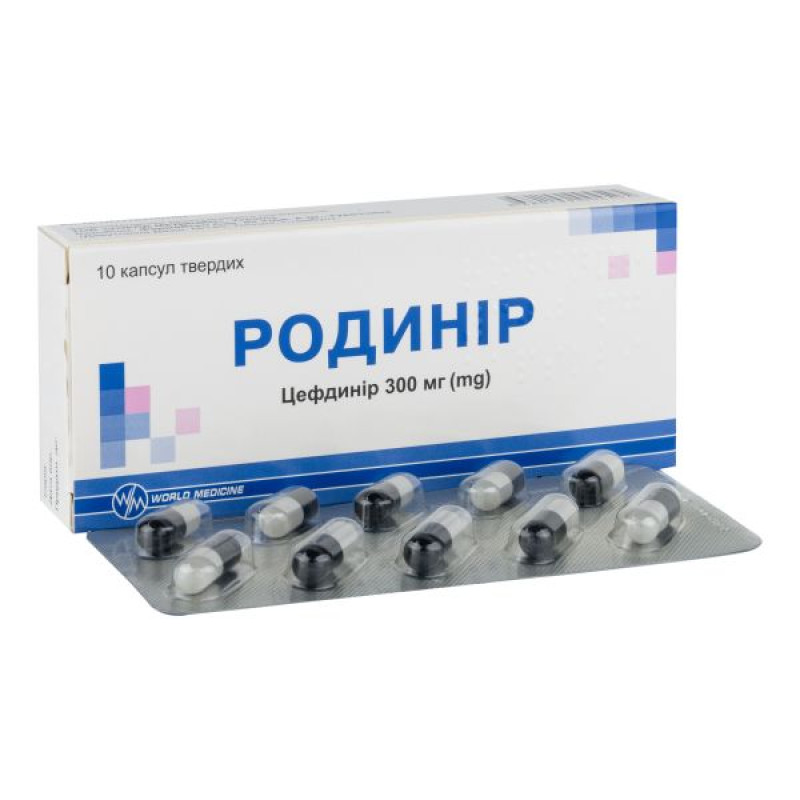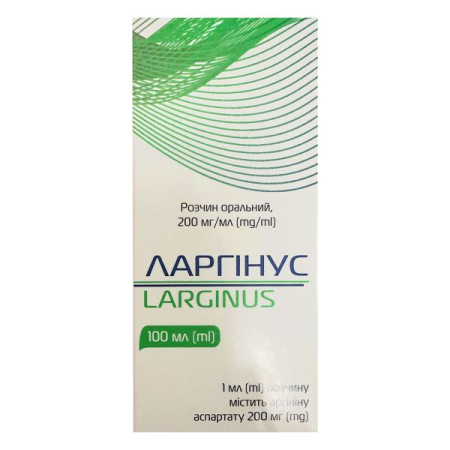Rodinir capsules 300mg No. 10

Instructions Rodinir capsules 300mg No. 10
Composition
active ingredient: cefdinir;
1 hard capsule contains cefdinir 300 mg;
excipients: carmellose calcium, polyoxide 40 stearate, colloidal anhydrous silicon dioxide, magnesium stearate; hard gelatin capsule: black iron oxide (E 172), titanium dioxide (E 171), gelatin.
Dosage form
The capsules are hard.
Main physicochemical properties: hard gelatin capsules, size No. 1, gray body, black cap, containing white to light yellow powder.
Pharmacotherapeutic group
Antimicrobials for systemic use. Other beta-lactam antibiotics. Third generation cephalosporins. ATX code J01D D15.
Pharmacological properties
Pharmacodynamics
Cefdinir is a third-generation, semi-synthetic, broad-spectrum oral cephalosporin antibiotic.
Like other cephalosporin antibiotics, cefdinir exerts bactericidal activity against susceptible microorganisms by inhibiting cell wall synthesis. It is resistant to the action of many beta-lactamases. As a result, many microorganisms resistant to penicillins and some cephalosporins are sensitive to cefdinir.
The spectrum of antimicrobial activity of cefdinir includes:
aerobic gram-positive microorganisms: Staphylococcus aureus (only strains sensitive to methicillin), Streptococcus pneumoniae (only strains sensitive to penicillin), Streptococcus pyogenes;
aerobic gram-negative microorganisms: Haemophilus influenzae, Haemophilus parainfluenzae, Moraxella catarrhalis.
The minimum inhibitory concentration (MIC) of cefdinir in vitro is 1 μg/mL or less for ≥ 90% of strains of the following microorganisms; however, its safety and efficacy in the treatment of diseases caused by these microorganisms have not been established in adequate and well-controlled clinical trials.
Aerobic gram-positive microorganisms: Staphylococcus epidermidis, Streptococcus agalactiae, Streptococcus viridans group.
Aerobic gram-negative microorganisms: Citrobacter Koseri, Escherichia coli, Klebsiella pneumoniae, Proteus mirabilis.
Cefdinir is inactive against most strains of Enterobacter spp., Pseudomonas spp., Enterococcus spp., penicillin-resistant strains of streptococci, and methicillin-resistant strains of staphylococci. Ampicillin-resistant strains of H. influenzae (non-beta-lactamase producing strains) are usually insensitive to cefdinir.
Pharmacokinetics
Absorption.
The time to reach maximum plasma concentration (Tmax) of cefdinir after oral administration is 2 to 4 hours. Plasma cefdinir concentrations increase with increasing dose, but the increase becomes less proportional in the dose range from 300 mg (7 mg/kg) to 600 mg (14 mg/kg). The bioavailability of cefdinir after oral administration of 600 mg capsules is 16%.
When cefdinir is taken with a fatty meal, the maximum plasma concentration (Cmax) and the area under the pharmacokinetic curve (AUC) are reduced by 16% and 10%, respectively. This decrease is considered to be clinically insignificant. Therefore, cefdinir can be used regardless of food intake.
The mean (± SD [standard deviation]) values of cefdinir pharmacokinetic parameters in plasma after administration of 600 mg capsules in adults are given below.
| Cmax (μg/ml) | Tmax (hours) | AUC (μg×h/mL) |
| 2.87 | 3 | 11.1 |
| (1.01) | (0.66) | (3.87) |
When administered once or twice daily in patients with normal renal function, cefdinir does not accumulate in the blood plasma.
Distribution.
The mean volume of distribution (Vdarea) of cefdinir in adult patients is 0.35 l/kg (± 0.29). The extent of cefdinir binding to plasma proteins in both adults and children is 60% to 70% and is independent of cefdinir concentration.
Skin blisters: In adults, the mean maximum concentration of cefdinir in blister fluid was 1.1 (0.49-1.9) mcg/mL and occurred 4-5 hours after a 600 mg dose. The mean (± standard deviation [SD]) Cmax and AUC(0-∞) values were 48% (± 13) and 91% (± 18) of the corresponding plasma values.
Tonsils: In adult patients undergoing elective tonsillectomy, the mean maximum concentration of cefdinir in tonsillar tissue was 0.36 (0.22-0.8) mcg/mL and was observed 4 hours after a single 600 mg dose. The mean (± SD) concentration values in tonsillar tissue were 24% (± 8) of the corresponding plasma values.
Sinus: In adult patients undergoing elective maxillary and ethmoidal sinus surgery, the mean maximum sinus tissue concentration of cefdinir was 0.21 (<0.12–2) μg/mL and was observed 4 hours after a single 600 mg dose. The mean (± SD) sinus tissue concentration was 16% (± 20) of the corresponding plasma values.
Middle Ear: In 14 pediatric patients with acute bacterial otitis media, the mean maximum concentration of cefdinir in middle ear fluid was 0.72 (0.14-1.42) μg/mL and was observed 3 hours after single doses of 7 and 14 mg/kg. The mean (± SD) middle ear fluid concentrations were 15% (± 15) of the corresponding plasma values.
There is no data on the penetration of cefdinir into the cerebrospinal fluid.
Metabolism and excretion.
Cefdinir is not significantly metabolized. It is excreted primarily by the kidneys. The mean elimination half-life (T1/2) is 1.7 (± 0.6) hours. In healthy volunteers with normal renal function, renal clearance (creatinine clearance [CC]) after taking 600 mg of cefdinir is 2.0 (± 1.0) ml/min/kg, oral clearance is 15.5 (± 5.4) ml/min·kg. The mean percentage of the administered dose excreted unchanged in the urine after taking a dose of 600 mg is 11.6% (± 4.6). Cefdinir clearance is reduced in patients with impaired renal function.
Since renal excretion is the major route of elimination of cefdinir, its dosage should be adjusted accordingly for patients with severe renal impairment and for patients undergoing hemodialysis.
Patients with renal failure.
In patients with creatinine clearance from 30 to 60 ml/min, Cmax and T1/2 were approximately 2-fold higher, AUC approximately 3-fold higher. In subjects with creatinine clearance < 30 ml/min, Cmax increased approximately 2-fold, T1/2 approximately 5-fold higher, AUC approximately 6-fold higher. For patients with severe renal impairment (creatinine clearance < 30 ml/min), the dosage regimen should be adjusted.
Patients on hemodialysis.
During dialysis (4 hours), 63% of cefdinir is removed from the body, and T1/2 is reduced from 16 (± 3.5) to 3.2 (± 1.2) hours. For patients on hemodialysis, it is recommended to adjust the dosage regimen.
Patients with impaired liver function.
Since cefdinir is primarily excreted by the kidneys and is not significantly metabolized, studies in patients with hepatic impairment have not been conducted. No dosage adjustment is recommended for such patients.
Elderly patients.
The systemic exposure to cefdinir was significantly increased in the elderly: Cmax and AUC by 44% and 86%, respectively. This is due to a decrease in its clearance. The volume of distribution was also reduced. Thus, no significant decrease in the mean half-life of cefdinir was observed (elderly patients: 2.2 ± 0.6 h, young patients: 1.8 ± 0.4 h). Since the clearance of cefdinir is primarily associated with changes in renal function, and not with age, there is no need for dosage adjustment in such patients.
Gender and race.
A meta-analysis of clinical pharmacokinetic studies (N = 217) demonstrated no significant effect of either gender or race on the pharmacokinetics of cefdinir.
Indication
Treatment of mild to moderate infections caused by susceptible microorganisms.
Adults and children aged 13 and over
Community-acquired pneumonia caused by:
Haemophilus influenzae (including beta-lactamase-producing strains);
Haemophilus parainfluenzae (including beta-lactamase-producing strains);
Streptococcus pneumonia (penicillin-sensitive strains only);
Moraxella catarrhalis (including beta-lactamase-producing strains).
Exacerbation of chronic bronchitis caused by:
Haemophilus influenzae (including beta-lactamase-producing strains);
Haemophilus parainfluenzae (including beta-lactamase-producing strains);
Streptococcus pneumonia (penicillin-sensitive strains only);
Moraxella catarrhalis (including beta-lactamase-producing strains).
Acute sinusitis caused by:
Haemophilus influenzae (including beta-lactamase-producing strains);
Streptococcus pneumonia (penicillin-sensitive strains only);
Moraxella catarrhalis (including beta-lactamase-producing strains).
Pharyngitis/tonsillitis due to:
Streptococcus pyogenes.
Uncomplicated skin and soft tissue infections caused by:
Staphylococcus aureus (including beta-lactamase-producing strains);
Streptococcus pyogenes.
Contraindication
Hypersensitivity to cefdinir, other cephalosporins and to other components of the drug.
Interaction with other medicinal products and other types of interactions
The following interactions are possible when cefdinir is used simultaneously with other drugs.
Antacids (aluminum or magnesium-containing).
Concomitant use with antacids reduces Cmax and the extent of absorption of cefdinir by approximately 40%. The time to reach Cmax is also prolonged by 1 hour. When these agents are used simultaneously, cefdinir should be taken at least 2 hours before or 2 hours after taking the antacid.
Iron supplements and iron-fortified foods.
Concomitant administration of iron supplements containing 60 mg elemental iron (as FeSO4) and vitamins containing 10 mg elemental iron reduces the absorption of cefdinir by 80% and 31%, respectively. When these agents are used concomitantly, cefdinir should be taken at least 2 hours before or 2 hours after taking the supplements.
The effect of foods fortified with elemental iron on the absorption of cefdinir has not been studied.
Cases of reddish stool discoloration have been reported in patients taking cefdinir. In many cases, patients were taking iron-containing products concomitantly. The reddish discoloration may be due to the formation of a complex of cefdinir or its degradation products with non-absorbed iron in the gastrointestinal tract.
When used simultaneously with probenecid, renal excretion of cefdinir may be impaired (as with other cephalosporins), leading to a 2-fold increase in AUC, Cmax by 54%, and T1/2 by 50%.
Interaction with laboratory tests.
When using cefdinir, false-positive results of the urine ketone test may be observed when nitroprusside is used.
Cefdinir may also cause false-positive results in urine glucose tests using Benedict's solution or Fehling's reagent. It is recommended that only enzymatic methods be used to determine glucosuria.
The use of cephalosporins can sometimes cause a false-positive Coombs test result.
Application features
In order to reduce the rate of development of antibiotic resistance, the drug should be used only for the treatment or prevention of infections caused by susceptible bacteria. In cases where information on the results of bacteriological cultures and susceptibility testing is available, it should be taken into account when selecting or changing antibacterial therapy. In the absence of such data, the empirical choice of therapy may be influenced by local epidemiological data and local characteristics of susceptibility patterns.
Cefdinir is effective in the treatment of oropharyngeal infections caused by Streptococcus pyogenes (S. pyogenes). However, the efficacy of cefdinir in the prevention of rheumatic fever following pharyngitis/tonsillitis caused by S. pyogenes has not been established.
The use of cefdinir in the absence of a proven or reasonably suspected bacterial infection or its prophylactic use is of questionable benefit to the patient and increases the risk of developing antibiotic resistance.
As with other broad-spectrum antibiotics, prolonged treatment with cefdinir may result in the overgrowth of non-susceptible organisms. The patient should be closely monitored. In the event of superinfection, appropriate alternative treatment should be instituted.
Impact on the immune system.
Before starting the drug, a history of hypersensitivity reactions to cefdinir, other cephalosporins, penicillins, or other drugs should be excluded.
When using the drug in patients with hypersensitivity to penicillins, utmost caution should be exercised, since cross-hypersensitivity between beta-lactam antibiotics has been proven in 10% of patients with a history of allergic reactions to penicillin.
If hypersensitivity reactions occur, the drug should be discontinued. In the event of serious allergic reactions, the administration of adrenaline and other emergency measures may be required, including oxygen, intravenous fluids, antihistamines, corticosteroids, pressor amines, and airway management as clinically indicated.
Effect on the digestive tract.
Clostridium difficile-associated diarrhea (C. difficile) has been reported with virtually all antibacterial agents, including cefdinir, and ranges in severity from mild diarrhea to fatal colitis. Antibacterial therapy alters the normal colonic flora, resulting in overgrowth of C. difficile. C. difficile produces toxins A and B, which contribute to pseudomembranous colitis. The hypertoxin produced by C. difficile strains is associated with increased morbidity and mortality because this infection may be resistant to antimicrobial therapy and may require colonectomy.
The possibility of pseudomembranous colitis should be considered in all patients with antibiotic-associated diarrhea. A careful medical history is essential because pseudomembranous colitis has been reported to occur more than 2 months after the use of antibacterial agents.
If pseudomembranous colitis is suspected or confirmed, the drug should be discontinued. Based on the clinical condition, the patient may be treated with appropriate fluid and electrolyte replacement, protein supplementation, antibiotic therapy to which C. difficile is susceptible, and surgical evaluation may be indicated.
Use in patients with a history of colitis.
The drug should be used with caution in such patients.
Use in patients with renal failure.
For patients with renal insufficiency (CC < 30 ml/min), the daily dose of the drug should be reduced, since use at recommended doses may lead to a significant increase in plasma concentrations and half-life of cefdinir.
Use during pregnancy or breastfeeding
Experimental reproduction studies in animals have not revealed any teratogenic effects.
There are no adequate and well-controlled studies of cefdinir in pregnant women. There are no data on the effects of cefdinir on labor.
During pregnancy, the use of the drug is possible only if there is a justified clinical need.
When using cefdinir at a dose of 600 mg, it is not detected in breast milk.
The drug does not affect the reaction speed when driving vehicles or other mechanisms.
Method of administration and doses
The medicine is intended for oral use. The capsules can be taken regardless of meals.
Adults and children aged 13 and over
The recommended dosage and duration of treatment for infections are listed in the table below. The total daily dose for the treatment of all infections is 600 mg. Taking cefdinir at a dose of 600 mg once a day for 10 days is as effective as taking cefdinir at a dose of 300 mg twice a day. Taking cefdinir once a day has not been studied in the treatment of pneumonia and skin infections, so in these cases the drug should be used twice a day.
Table
| Type of infection | Dosage | Duration |
| Community-acquired pneumonia | 300 mg every 12 hours | 10 days |
| Exacerbation of chronic bronchitis | 300 mg every 12 hours or 600 mg every 24 hours | 5–10 days or 10 days |
| Acute sinusitis | 300 mg every 12 hours or 600 mg every 24 hours | 10 days |
| Pharyngitis/tonsillitis | 300 mg every 12 hours or 600 mg every 24 hours | 5–10 days or 10 days |
| Uncomplicated skin and soft tissue infections | 300 mg every 12 hours | 10 days |
Patients with renal insufficiency
Adult patients with creatinine clearance (CC) < 30 ml/min should be administered at a dose of 300 mg once daily.
The following formula can be used to estimate creatinine clearance in adult patients. Plasma creatinine should reflect steady-state renal function.
[140 – age (in years)] × body weight (kg) 72 × plasma creatinine (mg/dL) | (× 0.85 for women) |
CC (ml/min) =
For children with creatinine clearance < 30 ml/min/1.73 m2, the drug should be administered at a dose of 7 mg/kg (up to 300 mg) once a day.
The following formula can be used to estimate the CC of children.
| CC (ml/min/1.73 m2) = 0.55 ´ height (cm)_________________ |
blood plasma creatinine (mg/dl)
Patients on hemodialysis
For patients on continuous hemodialysis, the recommended initial dose of the drug is 300 mg or 7 mg/kg every other day. At the end of each hemodialysis session, 300 mg (or 7 mg/kg) of cefdinir should be administered, with subsequent doses (300 mg or 7 mg/kg) administered every other day.
Patients with impaired liver function
No dosage adjustment is recommended for such patients.
Elderly patients
There is no need for dosage adjustment for such patients.
Children
The medicine should be used in children over 13 years of age.
Overdose
There are no data on overdose of cefdinir in humans. In acute toxicity studies in rodents, a single oral dose of cefdinir at a dose of 5600 mg/kg did not cause adverse reactions. The following symptoms have been reported with overdose of other cephalosporins: nausea, vomiting, gastric discomfort, diarrhea, and convulsions.
Cefdinir is removed from the body by hemodialysis, which may be useful in the event of serious toxic reactions caused by overdose, especially if the patient has impaired renal function.
Side effects
The following adverse reactions have been observed during clinical trials with cefdinir:
often (≥ 1/100 and < 1/10) - diarrhea, vaginal candidiasis, nausea, headache, abdominal pain, vaginitis;
infrequently (≥ 1/1000 and < 1/100) - rash, dyspepsia, flatulence, vomiting, changes in bowel movements, anorexia, constipation, dizziness, dry mouth, asthenia, insomnia, leukorrhea, candidiasis, itching, drowsiness.
Based on post-marketing experience with cefdinir, the following adverse reactions have been identified:
from the blood and lymphatic system - pancytopenia, granulocytopenia, leukopenia, thrombocytopenia, idiopathic thrombocytopenic purpura, hemolytic anemia, bleeding tendency, blood clotting disorders, generalized thrombohemorrhagic syndrome;
from the immune system - shock, anaphylaxis (in rare cases with fatal outcome), swelling of the face and larynx, feeling of suffocation, serum sickness, allergic vasculitis;
from the nervous system - loss of consciousness, involuntary movements;
on the part of the organs of vision - conjunctivitis;
on the part of the heart - heart failure, chest pain, myocardial infarction;
on the part of the blood vessels - hypertension;
from the respiratory system, chest organs and mediastinum - acute respiratory failure, asthma attack, drug-induced pneumonia, eosinophilic pneumonia, idiopathic interstitial pneumonia;
from the digestive tract - stomatitis, increased amylase levels, acute enterocolitis, hemorrhagic diarrhea, hemorrhagic colitis, melena, pseudomembranous colitis, bleeding from the upper digestive tract, peptic ulcer, intestinal obstruction;
from the hepatobiliary system - acute hepatitis, cholestasis, fulminant hepatitis, liver failure, jaundice;
Skin and subcutaneous tissue disorders: Stevens-Johnson syndrome, toxic epidermal necrolysis, exfoliative dermatitis, erythema multiforme, erythema nodosum;
from the kidneys and urinary system - acute renal failure, nephropathy;
general disorders and injection site reactions - fever.
The following adverse reactions have been reported with the use of cephalosporin antibiotics:
from the blood and lymphatic system - aplastic anemia, hemolytic anemia, hemorrhagic disorders, neutropenia, pancytopenia and agranulocytosis;
from the immune system - allergic reactions, anaphylaxis;
from the hepatobiliary system - liver dysfunction including cholestasis;
Skin and subcutaneous tissue disorders: Stevens-Johnson syndrome, erythema multiforme, toxic epidermal necrolysis;
from the kidneys and urinary system - impaired renal function, toxic nephropathy;
laboratory test results - false positive test for glucose in urine.
Pseudomembranous colitis can develop both during and after antibiotic treatment.
The use of some cephalosporins has been associated with the development of seizures, especially in patients with impaired renal function who have not undergone dosage adjustment. If seizures develop, the drug should be discontinued. Anticonvulsant therapy may be prescribed if clinically necessary.
Reporting of suspected adverse reactions.
Reporting adverse reactions after registration of a medicinal product is of great importance. This allows monitoring of the benefit/risk ratio when using this medicinal product. Medical and pharmaceutical professionals, as well as patients or their legal representatives, should report all cases of suspected adverse reactions and lack of efficacy of a medicinal product via the Automated Information System for Pharmacovigilance at the link: https://aisf.dec.gov.ua.
Expiration date
3 years.
Storage conditions
Store at a temperature not exceeding 25 °C out of the reach of children.
Packaging
10 capsules in a blister; 1 or 2 blisters in a cardboard box.
Vacation category
According to the recipe.
Producer
PharmaVision San. ve Tic. A.S., Turkey / PharmaVision San. ve Tic. AS, Turkey.
Location of the manufacturer and address of its place of business
Davutpasa Cad. No:145 Zeytinburnu Istanbul, Turkey.
Applicant
WORLD MEDICINE, LLC, Ukraine.
There are no reviews for this product.
There are no reviews for this product, be the first to leave your review.
No questions about this product, be the first and ask your question.









